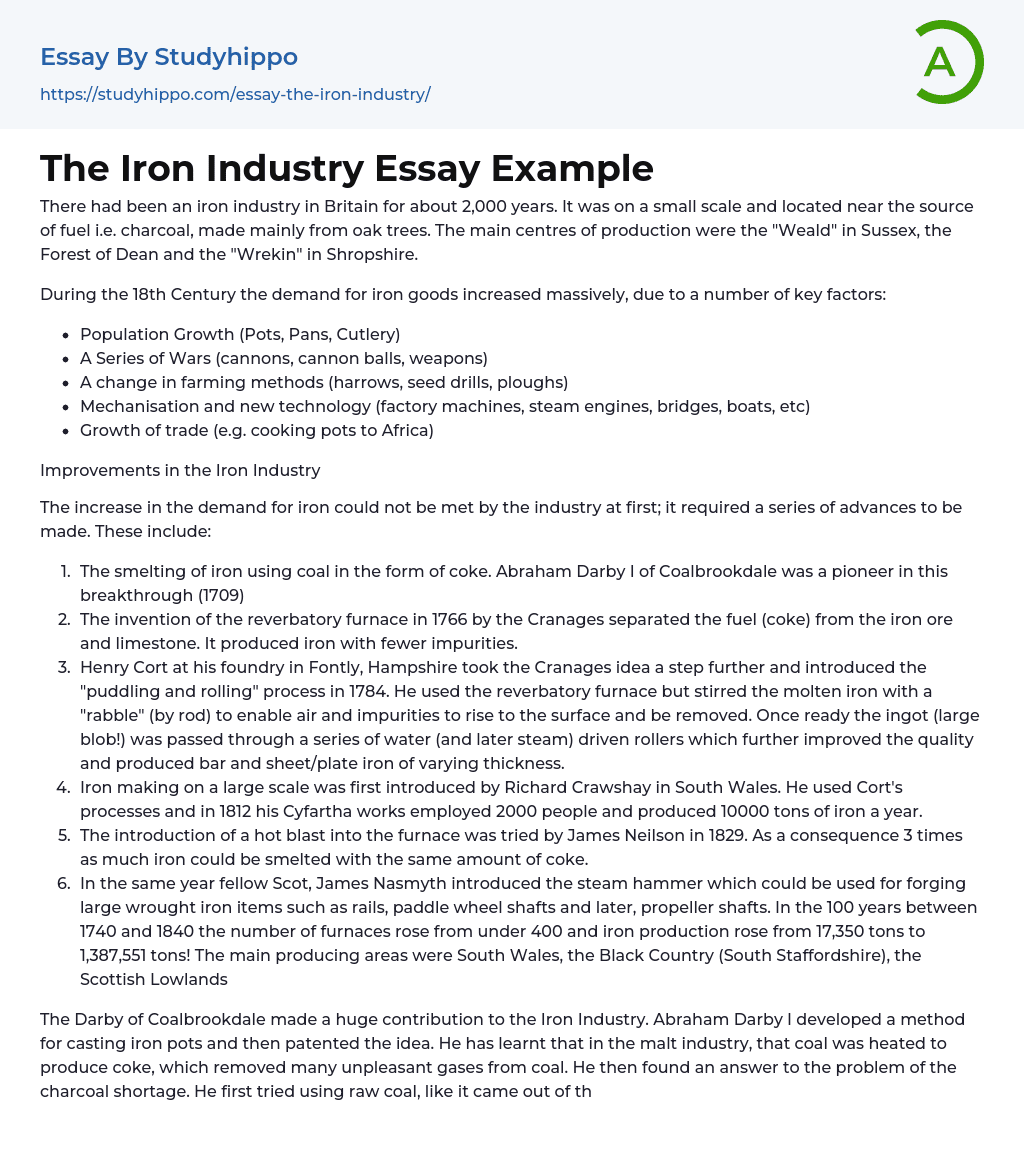There had been an iron industry in Britain for about 2,000 years. It was on a small scale and located near the source of fuel i.e. charcoal, made mainly from oak trees. The main centres of production were the "Weald" in Sussex, the Forest of Dean and the "Wrekin" in Shropshire.
During the 18th Century the demand for iron goods increased massively, due to a number of key factors:
- Population Growth (Pots, Pans, Cutlery)
- A Series of Wars (cannons, cannon balls, weapons)
- A change in farming methods (harrows, seed drills, ploughs)
- Mechanisation and new technology (factory machines, steam engines, bridges, boats, etc)
- Growth of trade (e.g. cooking pots to Africa)
Improvements in the Iron Industry
The increase in the demand for iron could not be met by the industry at first; it required a series
...of advances to be made. These include:
- The smelting of iron using coal in the form of coke. Abraham Darby I of Coalbrookdale was a pioneer in this breakthrough (1709)
- The invention of the reverbatory furnace in 1766 by the Cranages separated the fuel (coke) from the iron ore and limestone. It produced iron with fewer impurities.
- Henry Cort at his foundry in Fontly, Hampshire took the Cranages idea a step further and introduced the "puddling and rolling" process in 1784. He used the reverbatory furnace but stirred the molten iron with a "rabble" (by rod) to enable air and impurities to rise to the surface and be removed. Once ready the ingot (large blob!) was passed through a series of water (and later steam) driven rollers which further improved the quality and produced bar and sheet/plate iron of varying thickness.
- Iron makin
on a large scale was first introduced by Richard Crawshay in South Wales. He used Cort's processes and in 1812 his Cyfartha works employed 2000 people and produced 10000 tons of iron a year.
The Darby of Coalbrookdale made a huge contribution to the Iron Industry. Abraham Darby I developed a method for casting iron pots and then patented the idea. He has learnt that in the malt industry, that coal was heated to produce coke, which removed many unpleasant gases from coal. He then found an answer to the problem of the charcoal shortage. He first tried using raw coal, like it came out of the mines, but it wasn't successful. He then had the coal cooked to a cinder, which was very successful. It was not exactly a breakthrough, but it was a big technological advance.
The new method was fine for casting pots in mass production, but was not suitable for wrought iron. When Abraham Darby I died, his son in law Richard Ford managed the business until
Abraham Darby was old enough to run it, as he was only 6 at the time. Abraham Darby II took over in 1738. He borrowed a lot of money to improve the business and spent his money in many ways, such as buying a Newcomen steam engine, 6 new blast furnaces, the local coal and iron-ore mines; a horse powered tramway and developed an important new market making cast-iron boilers for steam engines.
He also significantly improved the quality, as the price was rising because of war, the price of charcoal was inceasing tremendously, and so Darby carried on experimenting, with different cooking methods, blast pressure, and different balances in ingredients. He once went one week without sleep. He then finally got the quality he wanted and took it to his forgers, who agreed. Over the next 20 years, the company made huge profits, and his work paid off selling pig iron to manufacturers.
Again, when Abraham Darby II died in 1763, his son in law Richard Reynolds took over till 1768, when Abraham Darby III was old enough to take over. Darby II was more of an innovator, making the worlds first iron bridge, a huge advertisement for his company. He was a good employer, buying farms and good homes to attract good workers. But in 50 years time, iron had improved so much that iron could be used for boats, steam engines and wheels. Soon there was a huge demand for the goods made by the company.
- Automotive essays
- Real Estate essays
- Construction essays
- E Commerce essays
- Commerce essays
- Polymers essays
- Automotive Industry essays
- Paper Industry essays
- Textile Industry essays
- Pharmaceutical industry essays
- Pharmacy essays
- Grocery stores essays
- Classical Mechanics essays
- Rail Transport essays
- Tata Motors essays
- Vehicle Brands essays
- trucks essays
- Auto Racing essays
- Harley-Davidson essays
- Suzuki essays
- Lexus essays
- Mercedes-Benz essays
- Buying Homes essays
- Futures Contract essays
- Mortgage Loan essays
- Renting essays
- Transaction Cost essays
- Building essays
- Optical Fiber essays
- Freezing essays
- Polymer essays
- Weaving essays
- Steel essays
- biofuel essays
- Coal essays
- Fuel essays
- Metals essays
- Oil essays
- Android essays
- Application Software essays
- Benchmark essays
- Computer Network essays
- Computer Programming essays
- Computer Security essays
- Computer Software essays
- Cryptography essays
- Data collection essays
- Data Mining essays
- Graphic Design essays
- Information Systems essays




